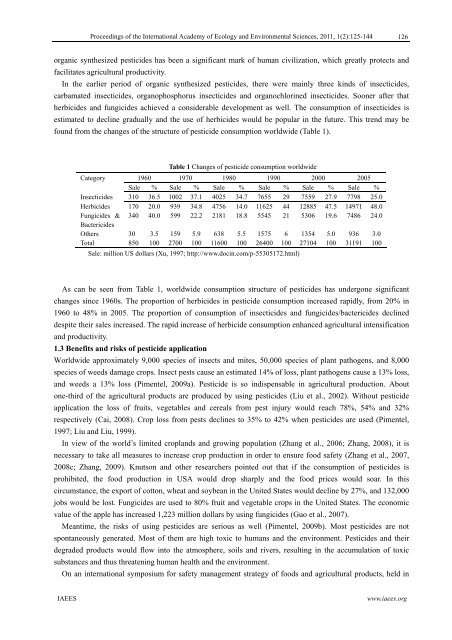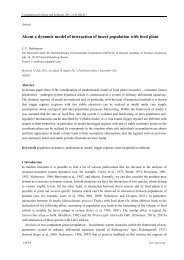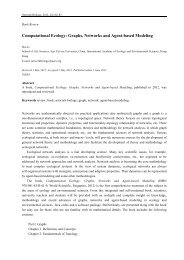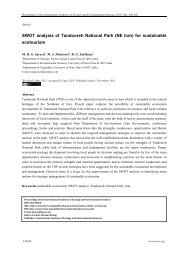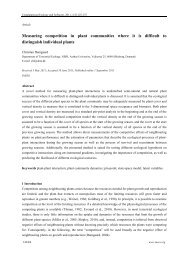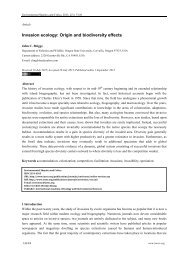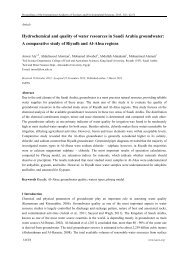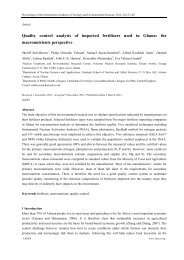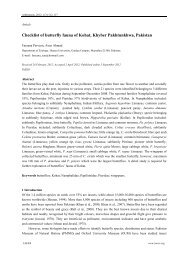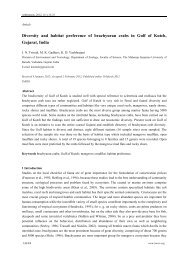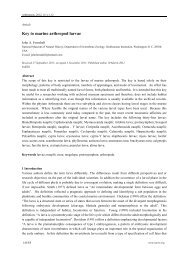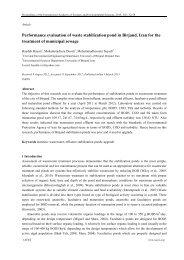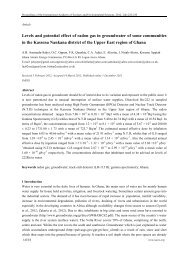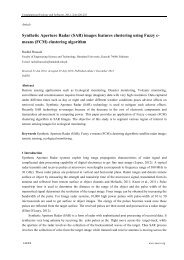Global pesticide consumption and pollution: with China as a focus
Global pesticide consumption and pollution: with China as a focus
Global pesticide consumption and pollution: with China as a focus
You also want an ePaper? Increase the reach of your titles
YUMPU automatically turns print PDFs into web optimized ePapers that Google loves.
Proceedings of the International Academy of Ecology <strong>and</strong> Environmental Sciences, 2011, 1(2):125-144<br />
126<br />
organic synthesized <strong>pesticide</strong>s h<strong>as</strong> been a significant mark of human civilization, which greatly protects <strong>and</strong><br />
facilitates agricultural productivity.<br />
In the earlier period of organic synthesized <strong>pesticide</strong>s, there were mainly three kinds of insecticides,<br />
carbamated insecticides, organophosphorus insecticides <strong>and</strong> organochlorined insecticides. Sooner after that<br />
herbicides <strong>and</strong> fungicides achieved a considerable development <strong>as</strong> well. The <strong>consumption</strong> of insecticides is<br />
estimated to decline gradually <strong>and</strong> the use of herbicides would be popular in the future. This trend may be<br />
found from the changes of the structure of <strong>pesticide</strong> <strong>consumption</strong> worldwide (Table 1).<br />
Table 1 Changes of <strong>pesticide</strong> <strong>consumption</strong> worldwide<br />
Category 1960 1970 1980 1990 2000 2005<br />
Sale % Sale % Sale % Sale % Sale % Sale %<br />
Insecticides 310 36.5 1002 37.1 4025 34.7 7655 29 7559 27.9 7798 25.0<br />
Herbicides 170 20.0 939 34.8 4756 14.0 11625 44 12885 47.5 14971 48.0<br />
Fungicides & 340 40.0 599 22.2 2181 18.8 5545 21 5306 19.6 7486 24.0<br />
Bactericides<br />
Others 30 3.5 159 5.9 638 5.5 1575 6 1354 5.0 936 3.0<br />
Total 850 100 2700 100 11600 100 26400 100 27104 100 31191 100<br />
Sale: million US dollars (Xu, 1997; http://www.docin.com/p-55305172.html)<br />
As can be seen from Table 1, worldwide <strong>consumption</strong> structure of <strong>pesticide</strong>s h<strong>as</strong> undergone significant<br />
changes since 1960s. The proportion of herbicides in <strong>pesticide</strong> <strong>consumption</strong> incre<strong>as</strong>ed rapidly, from 20% in<br />
1960 to 48% in 2005. The proportion of <strong>consumption</strong> of insecticides <strong>and</strong> fungicides/bactericides declined<br />
despite their sales incre<strong>as</strong>ed. The rapid incre<strong>as</strong>e of herbicide <strong>consumption</strong> enhanced agricultural intensification<br />
<strong>and</strong> productivity.<br />
1.3 Benefits <strong>and</strong> risks of <strong>pesticide</strong> application<br />
Worldwide approximately 9,000 species of insects <strong>and</strong> mites, 50,000 species of plant pathogens, <strong>and</strong> 8,000<br />
species of weeds damage crops. Insect pests cause an estimated 14% of loss, plant pathogens cause a 13% loss,<br />
<strong>and</strong> weeds a 13% loss (Pimentel, 2009a). Pesticide is so indispensable in agricultural production. About<br />
one-third of the agricultural products are produced by using <strong>pesticide</strong>s (Liu et al., 2002). Without <strong>pesticide</strong><br />
application the loss of fruits, vegetables <strong>and</strong> cereals from pest injury would reach 78%, 54% <strong>and</strong> 32%<br />
respectively (Cai, 2008). Crop loss from pests declines to 35% to 42% when <strong>pesticide</strong>s are used (Pimentel,<br />
1997; Liu <strong>and</strong> Liu, 1999).<br />
In view of the world’s limited cropl<strong>and</strong>s <strong>and</strong> growing population (Zhang et al., 2006; Zhang, 2008), it is<br />
necessary to take all me<strong>as</strong>ures to incre<strong>as</strong>e crop production in order to ensure food safety (Zhang et al., 2007,<br />
2008c; Zhang, 2009). Knutson <strong>and</strong> other researchers pointed out that if the <strong>consumption</strong> of <strong>pesticide</strong>s is<br />
prohibited, the food production in USA would drop sharply <strong>and</strong> the food prices would soar. In this<br />
circumstance, the export of cotton, wheat <strong>and</strong> soybean in the United States would decline by 27%, <strong>and</strong> 132,000<br />
jobs would be lost. Fungicides are used to 80% fruit <strong>and</strong> vegetable crops in the United States. The economic<br />
value of the apple h<strong>as</strong> incre<strong>as</strong>ed 1,223 million dollars by using fungicides (Guo et al., 2007).<br />
Meantime, the risks of using <strong>pesticide</strong>s are serious <strong>as</strong> well (Pimentel, 2009b). Most <strong>pesticide</strong>s are not<br />
spontaneously generated. Most of them are high toxic to humans <strong>and</strong> the environment. Pesticides <strong>and</strong> their<br />
degraded products would flow into the atmosphere, soils <strong>and</strong> rivers, resulting in the accumulation of toxic<br />
substances <strong>and</strong> thus threatening human health <strong>and</strong> the environment.<br />
On an international symposium for safety management strategy of foods <strong>and</strong> agricultural products, held in<br />
IAEES<br />
www.iaees.org


